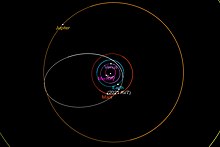2021 AV7
| Discovery [1][2] | |
|---|---|
| Discovered by | AMACS1(W94) Alain Maury G. Attard |
| Discovery site | San Pedro de Atacama |
| Discovery date | 15 January 2021(first observed) |
| Designations | |
| 2021 AV7 | |
| 11E401 [3] | |
| NEO·Apollo·PHA [4] | |
| Orbital characteristics [4] | |
| Epoch17 December 2021 (JD2459200.5) | |
| Uncertainty parameter1 [4] | |
| Observation arc | 4.81 yr (1,756 days) |
| Aphelion | 5.206AU |
| Perihelion | 0.8976 AU |
| 3.052 AU | |
| Eccentricity | 0.70587 |
| 5.33 yr | |
| 339.452° | |
| 0° 11m5.546s/ day | |
| Inclination | 29.400° |
| 153.486° | |
| 7 April 2021 03:28 UT [4] | |
| 39.043° | |
| EarthMOID | 0.00047 AU (70,000 km) |
| JupiterMOID | 0.78459 AU (117,373,000 km) |
| TJupiter | 2.650 |
| Physical characteristics | |
| 0.44–1.00km(assumedalbedo0.05–0.25)[5] | |
| 20.0(April 2021)[6] 19.8(at discovery)[1] | |
| 19.0±0.5[4] 19.0[2] | |
2021 AV7is anear-Earth asteroidof theApollo group,discovered by astronomersAlain Mauryand G. Attard atSan Pedro de Atacama,Chileon 15 January 2021. With an estimated diameter of 450–1,000 m (1,480–3,280 ft), it is considered apotentially hazardous asteroid.It has a highly ellipticalorbitthat brings it within Earth's orbit. Although its nominal orbit has a smallminimum orbit intersection distancearound 70,000 km (43,000 mi) from Earth's orbital path, the asteroid does not make any close approaches within 0.2astronomical units(30×106km; 19×106mi) over the next 100 years.[4]
Discovery
[edit]2021 AV7was discovered by astronomersAlain Mauryand G. Attard atSan Pedro de Atacama,Chileon 15 January 2021. It was first observed in theconstellationCanis Majorat anapparent magnitudeof 19.8.[1]The asteroid was moving at an on-sky rate of 1.15arcsecondsper minute, from a distance of 0.656 AU (98.1 million km; 61.0 million mi) from Earth.[7]
The asteroid was subsequently listed on theMinor Planet Center'sNear-Earth Object Confirmation Page(NEOCP) as 11E401.[3]Over three days, follow-up observations were carried out by various observatories includingSpacewatch(691)atKitt Peakand theSteward Observatory(I52)atMount Lemmon.The listing was confirmed and publicly announced as2021 AV7on 18 January 2021.[1]
Orbit and classification
[edit]
With a longobservation arcspanning over 4 years, the orbit of2021 AV7is well-secured with acondition codeof 1.[4]The earliest knownprecoveryobservations of2021 AV7are fromPan-STARRS 1on 9 July 2016. These precovery observations were published by the Minor Planet Center on 30 April 2021.[8]
2021 AV7orbits the Sun at an average distance of 3.05AUonce every 5.33 years. Its orbit has a higheccentricityof 0.71 and aninclinationof 29°with respect to theeclipticplane. Over the course of its orbit, its distance from the Sun ranges from 0.90 AU atperihelionto 5.2 AU ataphelion,crossing the orbits ofEarth,Mars,andJupiter.[4]Since its orbit crosses that of Earth's while having asemi-major axisgreater than 1 AU,2021 AV7is classified as anApollo asteroid.Although its nominal orbit has a smallminimum orbit intersection distancearound 0.00047 AU (70,000 km; 44,000 mi) from Earth's orbital path, the asteroid will not make any close approaches within 0.2astronomical units(30×106km; 19×106mi) over the next 200 years.[4]
Physical characteristics
[edit]Diameter and albedo
[edit]Based on an magnitude-to-diameter conversion and a measuredabsolute magnitudeof 18.9,2021 AV7measures between 440 and 1,000 meters in diameter for an assumedgeometric albedoof 0.25 and 0.05, respectively.[2][5]
References
[edit]- ^abcd"MPEC 2021-B45: 2021 AV7".Minor Planet Electronic Circular.Minor Planet Center.18 January 2021.Retrieved19 January2021.
- ^abc"2021 AV7".Minor Planet Center.International Astronomical Union.Retrieved19 January2021.
- ^ab"2021 AV7".NEO Exchange.Las Cumbres Observatory.18 January 2021.Retrieved19 January2021.
- ^abcdefghi"JPL Small-Body Database Browser: 2021 AV7"(2021-03-25 last obs.).Jet Propulsion Laboratory.Retrieved10 April2021.
- ^abBruton, Dan."Conversion of Absolute Magnitude to Diameter for Minor Planets".Department of Physics, Engineering, and Astronomy.Stephen F. Austin State University. Archived fromthe originalon 23 July 2011.Retrieved19 January2021.
- ^"2021AV7".Near Earth Objects – Dynamic Site.Department of Mathematics, University of Pisa, Italy.Retrieved19 January2021.
- ^"2021AV7 Ephemerides".Near Earth Objects – Dynamic Site(Ephemerides at discovery (obs. code W94)). Department of Mathematics, University of Pisa, Italy.Retrieved19 January2021.
- ^"MPEC 2021-H152: 2021 AV7".Minor Planet Electronic Circular.Minor Planet Center.30 April 2021.Retrieved6 May2021.
External links
[edit]- MAP program discoveries,Alain Maury, San Pedro de Atacama Celestial Explorations, 10 February 2021
- 2021 AV7atNeoDyS-2, Near Earth Objects—Dynamic Site
- 2021 AV7atESA–space situational awareness
- 2021 AV7at theJPL Small-Body Database



